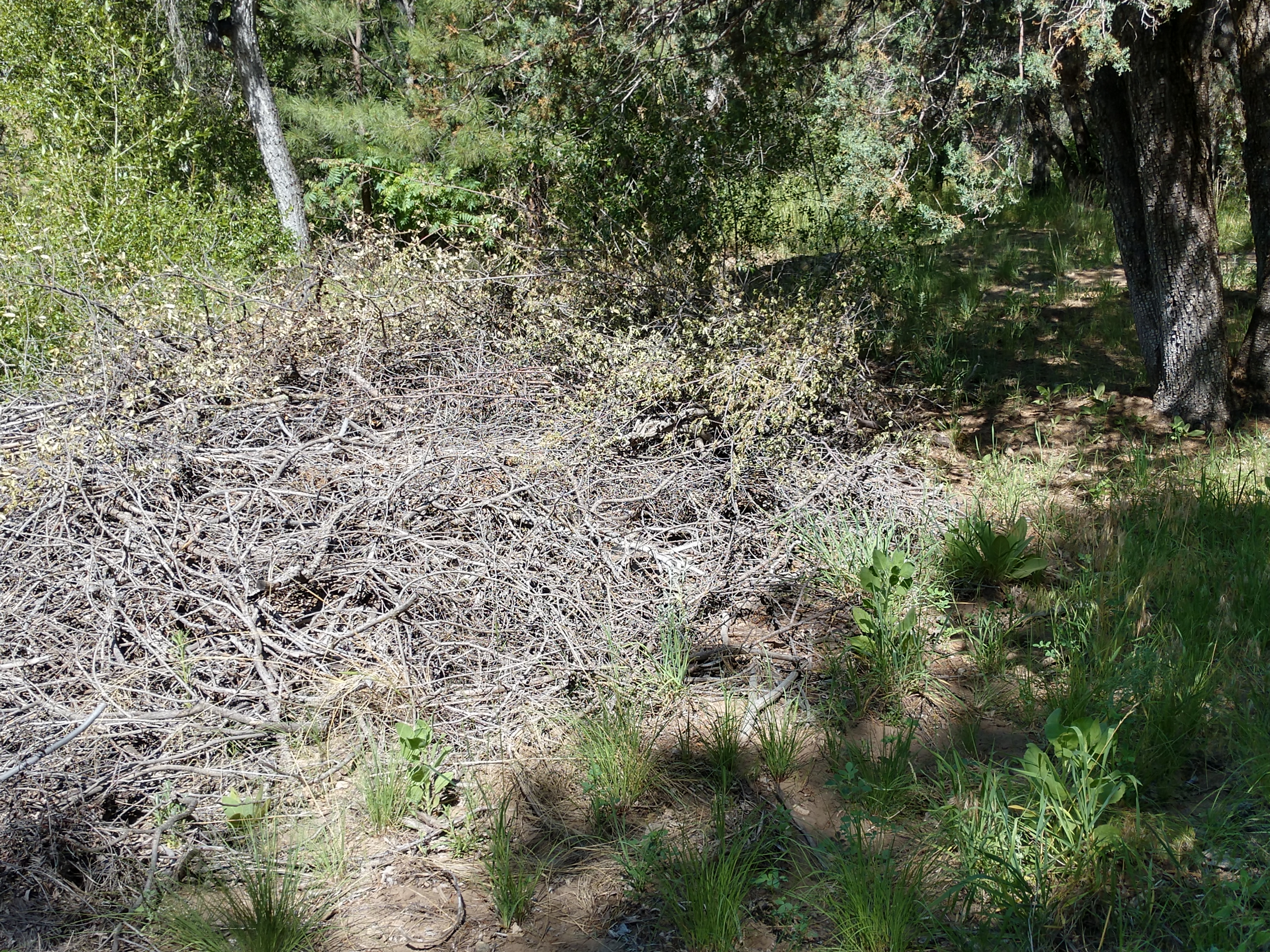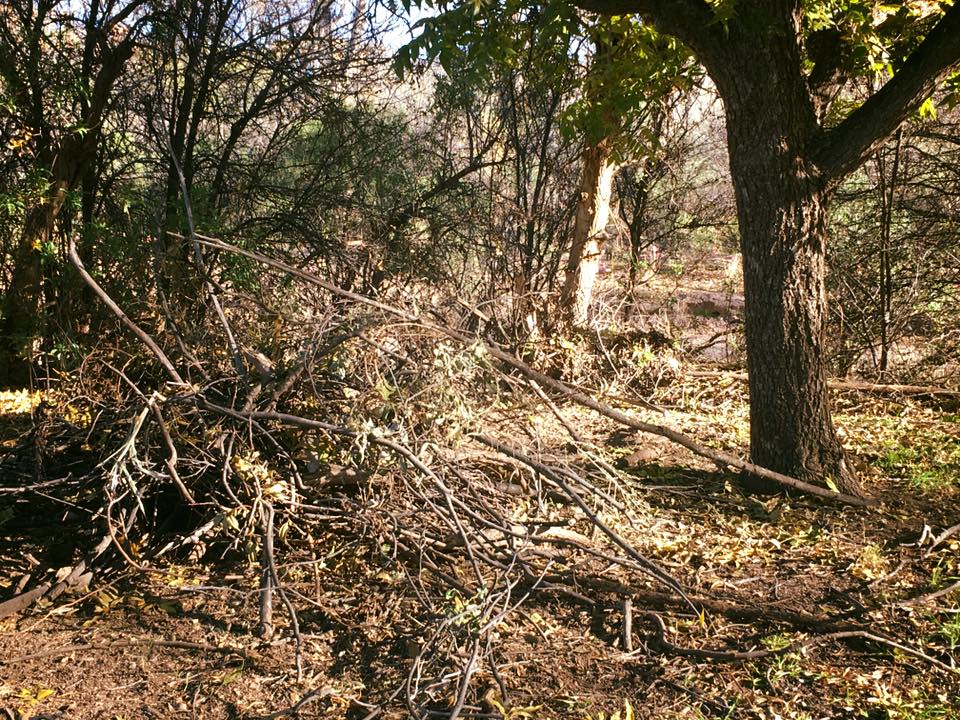 Brush Piles Benefit Wildlife - June 26, 2019 Jeff Schalau, Agent, Agriculture & Natural Resources University of Arizona Cooperative Extension, Yavapai County If you have a moderately large property, you may want to consider constructing and maintaining a brush pile to benefit ground nesting birds and ground dwelling animals. Brush piles create shelter that conceals and protects wildlife from predators and weather. They can also create a nursery for seed germination and subsequent plant growth. In our area, brush piles are very effective at creating habitat for Gambel’s quail. Brush piles constructed for quail will also be used by small rodents, snakes, and lizards. I highly recommend creating a brush pile if you enjoy wildlife viewing. First, you must decide if a brush pile would be acceptable in the neighborhood where you live (some communities have CC&R’s that restrict what may be present on your property). Second, it should be placed and sized as to minimize wildfire risk. Third, the brush pile should be placed in an area lacking suitable natural wildlife cover (shelter) but near enough to wildlife food sources and water that it will provide the desired benefits. The food source and water could be artificially or naturally created. My brush pile is located on the floodplain adjacent to the creek that runs through the property, but a bird feeder and/or artificial water source could provide the necessary enhancements. Once you have decided to create a brush pile, you may want to consider constructing it such that it has larger, rot-resistant materials for its foundation. These can be juniper logs or other more permanent materials such as medium sized stones or even broken concrete. This will provide areas where quail and other desired wildlife can have protected space close to the soil and create nesting areas. Finer brush materials are crisscrossed on top of this foundation and additional materials will periodically need to be added as the original materials decompose. The brush pile should also have some openings with six inches of clearance to allow quail easy access. Similarly, do not pack down the materials too tightly and leave some openings for access from the top of the brush pile. Larger brush piles will provide for larger numbers of wildlife; however smaller brush piles are better than no brush pile at all. Ideally, the brush pile should be at least twelve feet in diameter and five feet tall. Larger is fine, but eight feet in diameter and four feet tall is probably the smallest size that would effectively support a quail population. Smaller piles can provide refuge areas for quail looking to evade predators. People that feed birds know that small hawks (primarily Sharp-shinned and Cooper’s hawks in our area) are commonly attracted to feeders as they are “Accipitors” that prey primarily upon other bird species. Similarly, bird feeding can attract mice, woodrats and other small rodents. Cottontail rabbits and small rodents may also utilize brush piles. This, in turn, will attract other small predators and snakes that will use the small animals as a food source. Yes, the brush pile can become a food web of its own where many species benefit and others provide food. I’ve often observed Cooper’s hawks feeding on quail near my brush pile. This is to be expected and brush piles should and will benefit multiple species. If small rodents colonize your brush pile, expect bullsnakes, kingsnakes, and rattlesnakes to be present as well. The potential for attracting rattlesnakes is a good reason to construct brush piles a good distance away from where children and pets may have chance encounters. In my opinion, it is important for humans to accept all snakes as beneficial members of our local fauna. Bobcats, coyotes, and foxes may also be seen hunting for prey near brush piles providing fantastic opportunities to observe these animals enjoying a fresh meal. Brush piles are not for everyone and are not suitable for front yards of groomed landscapes. However, the backyard may have a suitable location for a brush pile. Gravel landscapes are generally not attractive to birds and wildlife. If you appreciate the presence of quail and other wildlife, the addition of a brush pile in the transition zone between groomed areas and more natural areas is one way to enhance habitat for the above mentioned species and provide additional habitat and great wildlife viewing opportunities. See the photo and additional information below. You can follow the Backyard Gardener on Twitter – use the link on the BYG website. If you have other gardening questions, call or email the Master Gardener help line in the Prescott (928-445-6590/prescottmg@gmail.com) or Camp Verde (928-554-8992/verdevalleymg@gmail.com) and be sure to include your name, address and phone number. Find past Backyard Gardener columns or provide feedback at the Backyard Gardener web site: http://cals.arizona.edu/yavapai/anr/hort/byg/. Photos  Brush pile at my home in Prescott, Arizona. It is many years old and it has needed periodic additions of materials. It is on the floodplain adjacent to Miller Creek. Gambel's quail have nested in it many times over the years (Jeff Schalau, University of Arizona).
Brush pile at my home in Prescott, Arizona. It is many years old and it has needed periodic additions of materials. It is on the floodplain adjacent to Miller Creek. Gambel's quail have nested in it many times over the years (Jeff Schalau, University of Arizona). Brush pile at Tucson's Paton Center for Hummingbirds (from: @patonhummingbirds on Facebook).
Brush pile at Tucson's Paton Center for Hummingbirds (from: @patonhummingbirds on Facebook).Additional Resources Wildlife Management: Brush Piles, University of Maryland Cooperative Extension extension.umd.edu/sites/extension.umd.edu/files/_docs/programs/woodland-steward/FS599_WMgtBrushPiles.pdf Brush Piles, YardMap by:The Nature Conservancy and The Cornell Lab content.yardmap.org/learn/brushpiles/ Wildlife Shelters: Brush Piles and Predator Excluders, Iowa State University Extension and Outreach www.extension.iastate.edu/smallfarms/wildlife-shelters-brush-piles-and-predator-excluders |